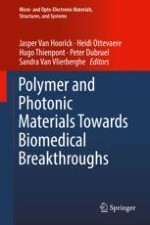2018 | Buch
Polymer and Photonic Materials Towards Biomedical Breakthroughs
herausgegeben von: Dr. Jasper Van Hoorick, Prof. Heidi Ottevaere, Hugo Thienpont, Dr. Peter Dubruel, Sandra Van Vlierberghe
Verlag: Springer International Publishing
Buchreihe : Micro- and Opto-Electronic Materials, Structures, and Systems
